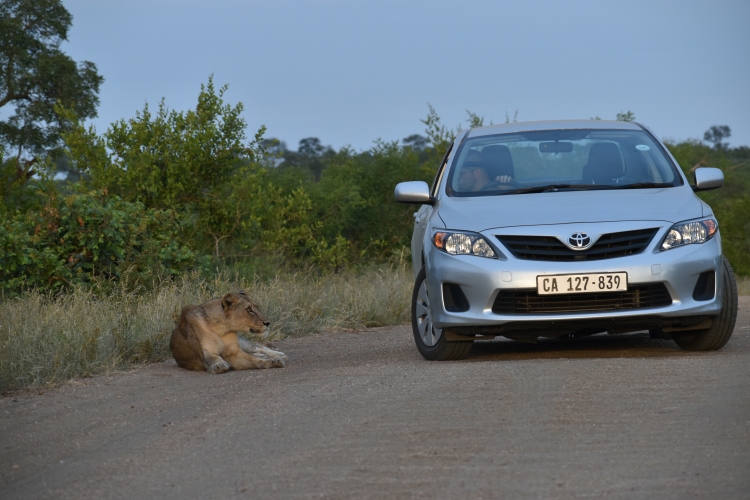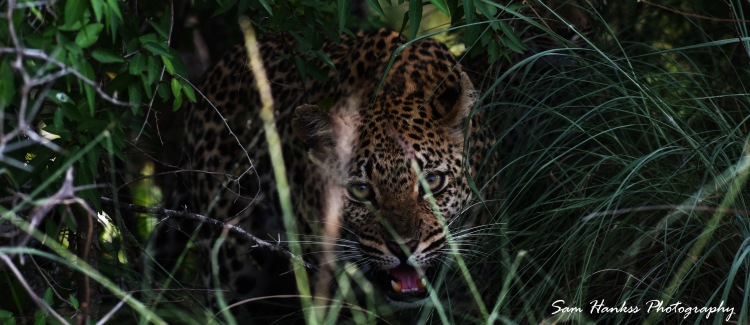
For the past few weeks, I have had the distinct pleasure of following Sam Hankss: a London-born safari guide living and working in Africa. Sam writes about his life and adventures on his blog, The Life of a Safari Guide, where he also shares his incredible photography. Sam’s blog has quickly become one of my favorites.
I recently asked Sam to write a guest post about the five most common mistakes visitors make while on safari. Avoiding these pitfalls will enhance your safari experience: both for yourself and the wildlife. Without further ado, here is Sam’s post:
Introduction
I must begin by saying that is an absolute pleasure to have been asked to write and share this with you on behalf of Josh. His blog is fantastic and it is a privilege to be asked to share my thoughts and help educate some of his readers.
When people go on safari, whether they self-drive or have guides taking them out, the excitement is uncontrollable. Even for me, a guide myself, I often get carried away when I spot various animals. Yet there are certain things I will always adhere to. When you go on safari, you are contributing hugely to eco-tourism. Yet for this industry to carry on thriving in a safe manner whilst having the least amount of impact upon the animals and the environment, certain mistakes need to be rectified. Here I will be discussing a number of these issues.
1. Driving too Fast
Every reserve has a speed limit, whether you are in the Serengeti National Park or on a private game reserve in South Africa. If you break these limits, the likelihood of not spotting a Tortoise on the road (or any other small animal for that matter) is extremely high and unfortunately once realised, it is too late.

This, however, does not mean you have to drive at that limit all of the time. On my reserve, the limit on the main roads is 40km/h (25 mph); yet it is very rare that we actually reach that speed. This is because animals are very sensitive to speed. If you approach an animal head on at 40km/h, I guarantee your sighting will be short-lived and disruptive to their natural behaviour. The slower the better.
2. Getting too Close
There is nothing more exciting than a close encounter with a dangerous animal. It gets my adrenalin pumping and the photo opportunities are great, but there is a strategy. DO NOT drive head on into an animal’s space. Just like humans, they don’t like people invading their personal space, and why should they? If you do this the animal may react aggressively (charging your vehicle) or it may run away. Either option spoils the sighting for you and everyone else.
Instead, keep your distance and stop your car. Let the animal approach you. If you find a spot to stop, you are there before the animal – so if it wants to come and say hello, it will. If it doesn’t, it has enough space to move off.
3. Spotlighting
An essential part of an afternoon/night drive is spotlighting. The level of anticipation is even higher when eye-shine is seen, giving us the whereabouts of an animal.
The biggest mistake, however, is spotlighting on diurnal animals. The spotlight actually causes the diurnal animal to become temporarily blinded and disorientated. When approaching diurnal animals, especially elephants and rhinos, turn all bright lights off. This will help keep them calm and not disturb them.

One very debateable subject is spotlighting during a hunt. When spotlighting during a night hunt, the problems arise that if you spotlight the prey, it becomes blinded and therefore an unnatural kill is made. Or the predator is spotlighted: revealing the whereabouts of the hunter. I therefore turn all lights off. Often the moon is bright enough to help us see what is happening, and as soon as contact is made between prey and predator I spotlight the scene.
4. Noise and Movement from Within the Vehicle
Although the animals you will encounter will generally be used to vehicles, noises and movement from inside the vehicle can impact massively on an encounter. The most critical part of an animal encounter is the first minute; this minute will tell you if the animal is relaxed, nervous or grumpy. That is why if I see people laughing and screaming loudly in sightings I tell them to button up. Loud, unexpected noises scare animals and can lead to them either running away or becoming agitated, none of which is favourable.
Stay quiet and move slowly and you are guaranteed a good sighting.

5. Flash Photography
Nothing aggravates me more than people using flash photography on animals, especially when I have told them not to. The reason I have such hatred for it is because (just like the spotlighting) it temporarily blinds diurnal animals and generally aggravates or scares off nocturnal animals.
My first warning to guests is I will tell them off if they use flash. If they do it a second time, I threaten to throw their camera to the lions! If you are unsure about how to get the best pictures in low-light conditions, look it up before you go on safari or ask your guide. Many of us have cameras of our own and are quite handy with hints and tips!
I hope you have enjoyed a little insight into what no to do on safari and I hope you take what I have said into consideration. The most important thing however is to enjoy it. Be at one with nature and forget about everyday life. No matter what happens, you will have experiences you will never forget.
I want to thank Sam for agreeing to do this guest post. Please, take some time to check out his excellent blog!



Great post, Josh and very informative. Being from South Africa I knew about most of these, but… I have never actually been on a safari – I guess because I was born there it had less of an appeal – I have however been on a drive through in a smaller game reserve in the Eastern Cape. Here’s an important one to add to your list: keep your windows closed and down hang out of the window… I know – it may seem pretty obvious, but a lot of people make this mistake anyway and put themselves at risk.
LikeLiked by 2 people
Hi Jacques! I hadn’t realized you were from South Africa. Yes, keeping the windows up is a great bit of advice. I could definitely see a curious, juvenile lion sticking its head in an open car window; the consequences might be bad both for the lion and the tourist.
LikeLiked by 1 person
Josh, yes, I’m from there originally, but have spent more than half my adult life living and travelling abroad, but I go back there every once in a while for a visit.
Josh, here’s an example of what could happen when you leave your car window open….
LikeLiked by 1 person
Great post :) I hope I get to go on a Safari someday!
LikeLiked by 1 person
As do I! If you ever do get to go on a safari, now you know five things that you shouldn’t do ;)
LikeLiked by 1 person
I can see people doing every one of these faux pas. It’s none of our natural habitats so I can see how we may err.
LikeLiked by 1 person
Indeed. That’s why it’s so valuable to have Sam’s input, because he knows a lot more about how to properly behave in the bush than most of us.
LikeLiked by 1 person
I can see that, I would never do a trip like this without some input. Your error could cost you…
LikeLiked by 1 person
Great post Josh, really awesome – reminds me of many an unlucky day in reserves myself when younger with a father who should have known better – hey ho.
LikeLiked by 1 person
There’s not much we can do about past mistakes except learn from them. My hope is that this collaboration between Sam and I will help prevent someone else from making one of these errors while on safari.
LikeLiked by 1 person
That’s the spirit my friend, positive thoughts and motivation is what makes for the greatest of change.
LikeLiked by 1 person
Fascinating post Josh, even to someone who well set foot on a safari. Humans have to understand that animals have their own minds and personalities.
LikeLiked by 1 person
If you can’t physically go to Africa for a safari, you can watch one digitally here:
https://www.nationalgeographic.com/video/safari-live/
That link is to a program that literally streams an African safari around the world 2x per day. It’s the next best thing to actually being there in person ;)
LikeLiked by 1 person
Thanks Josh. I’m going to take a look at it now.
LikeLiked by 1 person
OMG those baby lions!
LikeLiked by 1 person
Haha yea, lion cubs are the best! They’re so full of energy, and their disproportionately large paws are adorable.
LikeLiked by 1 person
Is it true Josh, that house cats and the big cats share the same habits and temperament?
LikeLiked by 1 person
Not exactly the same, no. There’s definitely some overlap, such as in the fact that different individuals within the same species can have distinct personalities. But house cats have been domesticated for thousands of years, whereas big cats have not. So the latter are more ‘wild,’ AKA less predictable.
LikeLiked by 1 person
Years ago, I saw a nature study of community feral house cats that lived in a large vacant lot in New York. There were lots of hiding places but the point of the study is that house cats are less kittenish when they are on their own and much more like the big cats. The conclusion of the study was that cats adapted to humans by retaining their ‘kitten’ behaviors.
LikeLiked by 1 person
That makes sense. I know that meowing is a sound that is normally only made by kittens, but adult cats meow at us because they’ve learned that they can manipulate us by doing so.
LikeLiked by 1 person
Oh yes. My favorite is the truly heartbreaking whisper meow. My cat could get anything from me with that one.
LikeLiked by 1 person
Haha, they certainly know how to manipulate us.
LikeLiked by 1 person
LOL..they get extra kibble when they do it with half shit eyes.
LikeLiked by 1 person
Beautiful share!! Fabulous clicks! Animal lovers unite! ❤️
LikeLiked by 1 person
Wonderful post. Visiting a wildlife reserve is an amazing experience.
I had an encounter with lion in Jim Corbett national park. That was terrific and just like Sam’s elephant he approached us himself.😃
LikeLiked by 1 person
Oh wow, your lion encounter sounds incredible! It’s amazing what can happen when you give animals the chance to approach you on their own terms :)
LikeLike
It’s incredible.
It makes us realise that they are the host and we are their guests.
LikeLiked by 1 person
Indeed!
LikeLike
😃
LikeLiked by 1 person
Wow these are such useful tips!
LikeLiked by 1 person
Yep, Sam did a great job on the post!
LikeLike
You will also enjoy reading this post
https://wp.me/p5MfZK-1c
LikeLiked by 1 person